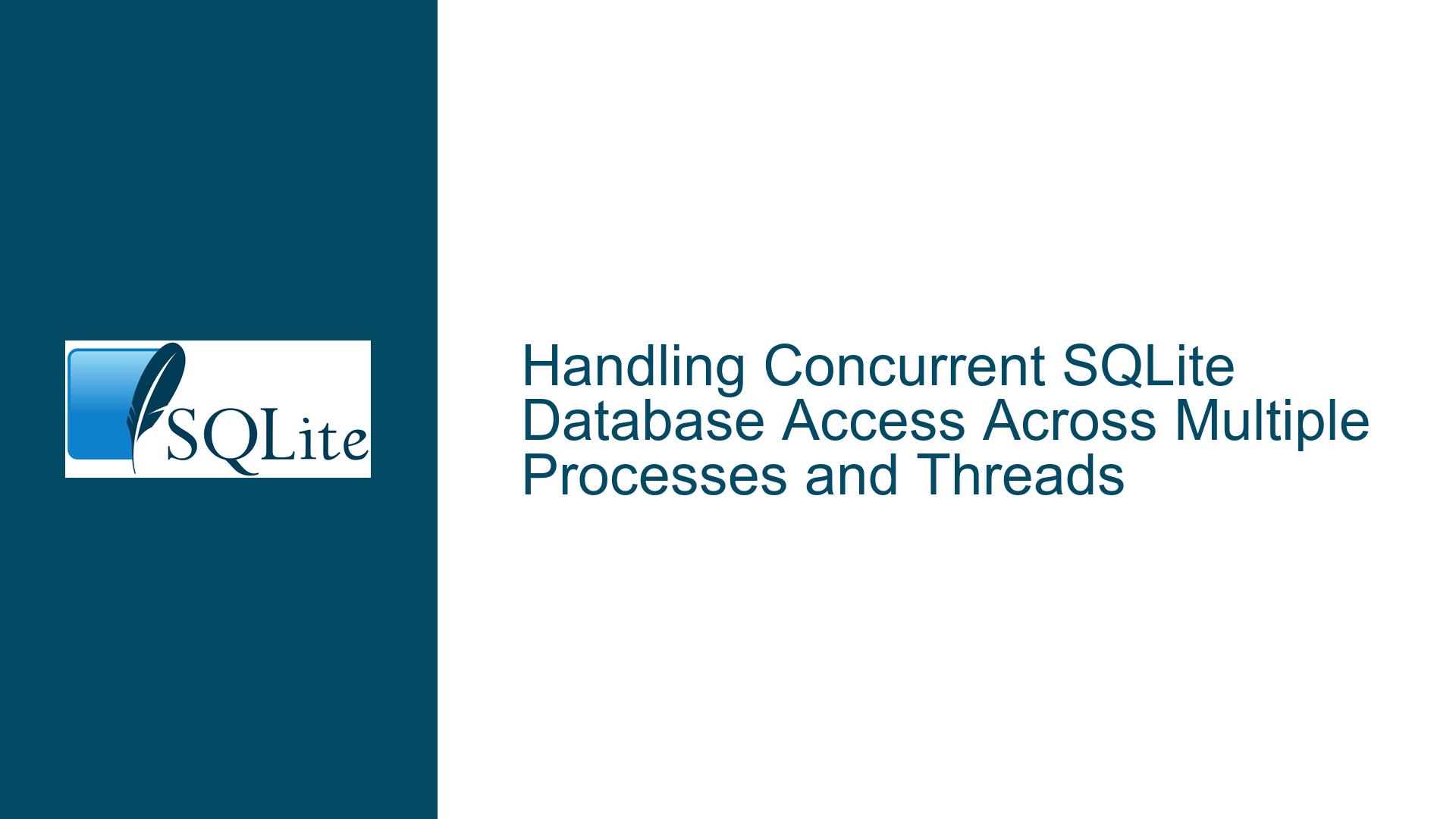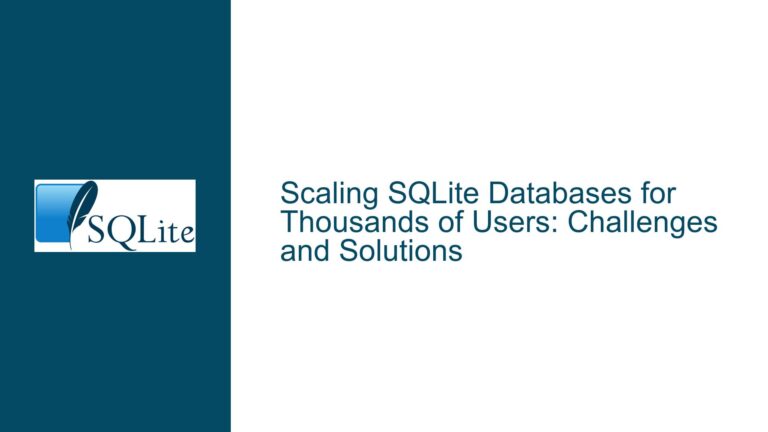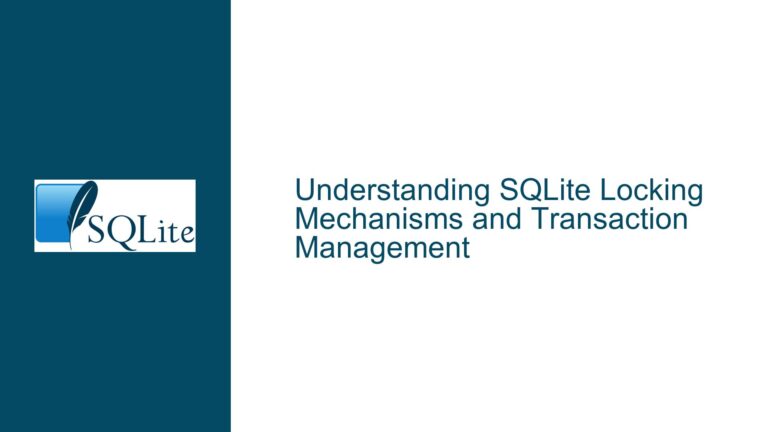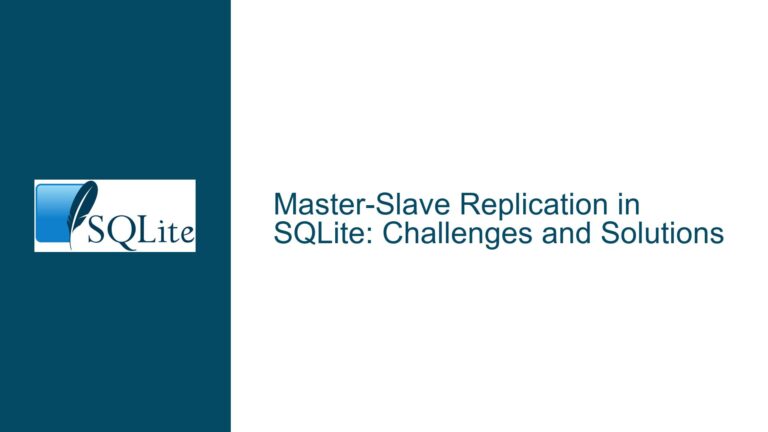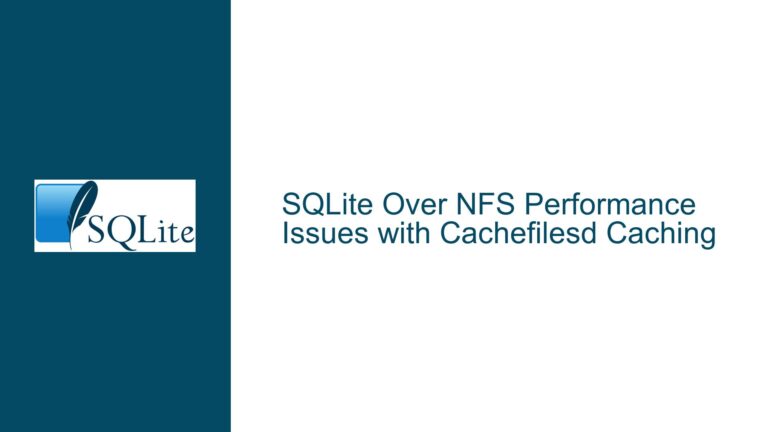Handling Concurrent SQLite Database Access Across Multiple Processes and Threads
Issue Overview: Concurrent Database Initialization and Read-Only Access in SQLite
The core issue revolves around managing concurrent access to an SQLite database that is shared across multiple processes and threads. The database is created and initialized by the first process that accesses it, after which it becomes read-only for all subsequent processes. The challenge lies in ensuring that the database initialization is thread-safe and process-safe, while also allowing for efficient read-only access by potentially thousands of processes and threads. Additionally, the solution must support both in-memory and on-disk databases, with a focus on minimizing contention and maximizing performance.
The primary concerns are:
Database Initialization Race Conditions: When multiple processes or threads attempt to initialize the database simultaneously, there is a risk of race conditions. If two processes attempt to create the database at the same time, one may fail or overwrite the work of the other. This requires a mechanism to ensure that only one process or thread can initialize the database, while others wait or retry.
Concurrent Read-Only Access: Once the database is initialized, it is used in a read-only manner by multiple processes and threads. The solution must ensure that read operations do not block each other and that the database can handle a high volume of concurrent read requests without performance degradation.
In-Memory vs. On-Disk Databases: The solution must support both in-memory and on-disk databases. In-memory databases are easier to manage in terms of concurrency since each process has its own copy, but they may not be practical for large datasets or when sharing data across processes is necessary. On-disk databases require careful handling of file locks and concurrency to ensure data integrity and performance.
Database File Sharing: If the database is stored on the filesystem, it must be shared across multiple processes. This introduces challenges related to file locking, especially during the initialization phase. SQLite uses internal locking mechanisms to manage concurrent access, but these must be understood and configured correctly to avoid issues such as SQLITE_BUSY errors.
Database File Transfer: One proposed solution involves receiving the SQLite database file from a remote service via HTTP. This introduces additional considerations, such as how to handle the binary transfer of the database file and ensuring that the file is correctly written to disk before being accessed by multiple processes.
Possible Causes: Why Concurrent Access and Initialization Can Fail
Race Conditions During Initialization: When multiple processes or threads attempt to initialize the database simultaneously, race conditions can occur. For example, one process may check if a table exists, find that it does not, and begin creating it. Meanwhile, another process may perform the same check and also attempt to create the table, leading to conflicts or errors.
SQLITE_BUSY Errors: SQLite uses file locks to manage concurrent access to the database. If one process is writing to the database (e.g., during initialization), other processes may receive SQLITE_BUSY errors when attempting to access the database. This can happen if the database is not configured correctly or if the processes do not handle these errors properly.
Improper Use of Transactions: Transactions are crucial for ensuring data integrity during database initialization. If transactions are not used correctly, multiple processes may interfere with each other’s operations. For example, if a process begins a transaction but does not commit it promptly, other processes may be blocked or receive errors.
File Locking Issues: SQLite uses file locks to prevent multiple processes from writing to the database simultaneously. However, if the file locking mechanism is not configured correctly (e.g., if the database is not in WAL mode), processes may experience contention and performance issues.
In-Memory Database Limitations: While in-memory databases are easier to manage in terms of concurrency, they have limitations. Each process has its own copy of the database, which can lead to high memory usage if the dataset is large. Additionally, sharing data between processes requires additional mechanisms, such as inter-process communication (IPC).
Improper Handling of Binary Database Files: If the database is received as a binary file via HTTP, improper handling of the file transfer or writing process can lead to corruption or incomplete data. This can cause issues when multiple processes attempt to access the database.
Troubleshooting Steps, Solutions & Fixes: Ensuring Safe and Efficient Concurrent Access
1. Database Initialization with BEGIN IMMEDIATE and IF NOT EXISTS
To safely initialize the database across multiple processes and threads, use the BEGIN IMMEDIATE transaction mode combined with IF NOT EXISTS clauses in your schema creation statements. This ensures that only one process can initialize the database at a time, while others wait or retry.
Step 1: Check Database Validity: When a process starts, it should first check if the database is valid by querying the schema (e.g., checking if a specific table exists). If the database is not valid, the process should proceed to initialize it.
Step 2: Begin an Immediate Transaction: Before attempting to initialize the database, the process should start an immediate transaction using
BEGIN IMMEDIATE. This ensures that no other process can write to the database until the transaction is committed.Step 3: Recheck Database Validity: After starting the transaction, the process should recheck the database validity. This is necessary because another process may have initialized the database while the current process was waiting to start the transaction.
Step 4: Initialize the Database: If the database is still not valid, the process should proceed to create the necessary tables and indexes using
CREATE TABLE IF NOT EXISTSand similar statements. This ensures that the schema creation is idempotent and will not fail if the tables already exist.Step 5: Commit the Transaction: Once the database is initialized, the process should commit the transaction. This releases the lock and allows other processes to access the database.
Step 6: Handle SQLITE_BUSY Errors: If a process receives a SQLITE_BUSY error when attempting to start an immediate transaction, it should wait and retry. The retry logic should include a backoff mechanism to avoid excessive contention.
2. Configuring SQLite for Concurrent Read-Only Access
Once the database is initialized, it will be used in a read-only manner by multiple processes and threads. To ensure efficient concurrent access, configure SQLite as follows:
Enable WAL Mode: Write-Ahead Logging (WAL) mode allows multiple readers to access the database simultaneously while a single writer is active. This improves concurrency and reduces contention. Enable WAL mode by executing the following command:
PRAGMA journal_mode=WAL;.Set Connection Timeouts: Each connection to the database should have a timeout value set to handle SQLITE_BUSY errors gracefully. Use the
sqlite3_busy_timeoutfunction to set a timeout (e.g., 5000 milliseconds) for each connection.Use Immutable Mode for Read-Only Databases: If the database is read-only and will not change after initialization, open it in immutable mode by specifying
file:database.db?immutable=1in the connection string. This improves performance by bypassing certain locking mechanisms.Optimize Read-Only Queries: Ensure that read-only queries are optimized to minimize contention. Use indexes where appropriate, and avoid long-running queries that could block other processes.
3. Handling In-Memory Databases
If an in-memory database is used, each process will have its own copy of the database. This eliminates the need for inter-process synchronization but introduces other considerations:
Memory Usage: In-memory databases can consume significant memory, especially if the dataset is large. Monitor memory usage and consider using on-disk databases if memory becomes a constraint.
Data Sharing: If data needs to be shared between processes, consider using inter-process communication (IPC) mechanisms to synchronize the in-memory databases. Alternatively, use an on-disk database to share data between processes.
Initialization: Since each process has its own copy of the in-memory database, initialization is simpler. However, ensure that the initialization logic is consistent across processes to avoid discrepancies.
4. Handling Binary Database File Transfers
If the database is received as a binary file via HTTP, ensure that the file is correctly written to disk before being accessed by multiple processes:
Step 1: Receive the Database File: When the database file is received via HTTP, write it to a temporary location on disk. Ensure that the file is fully written and closed before proceeding.
Step 2: Verify the Database File: After writing the file, verify its integrity by opening it with SQLite and performing a basic query (e.g., checking the schema). This ensures that the file was not corrupted during transfer.
Step 3: Move the Database File: Once the file is verified, move it to its final location. This ensures that the file is not accessed by other processes until it is fully ready.
Step 4: Open the Database in Read-Only Mode: Open the database in read-only mode to prevent any accidental modifications. Use the
file:database.db?immutable=1connection string to open the database in immutable mode.
5. General Best Practices for Concurrent SQLite Access
Use Connection Pooling: If your application uses multiple threads, consider using connection pooling to manage database connections. This reduces the overhead of opening and closing connections and improves performance.
Monitor Performance: Monitor the performance of your database under concurrent access. Use tools like
EXPLAIN QUERY PLANto analyze query performance and identify bottlenecks.Handle Errors Gracefully: Ensure that your application handles SQLITE_BUSY and other errors gracefully. Implement retry logic with appropriate backoff mechanisms to avoid excessive contention.
Test Under Load: Test your application under realistic load conditions to ensure that it can handle the expected number of concurrent processes and threads. Use stress testing tools to simulate high concurrency and identify potential issues.
By following these steps and best practices, you can ensure safe and efficient concurrent access to an SQLite database across multiple processes and threads. Whether using an in-memory or on-disk database, careful handling of initialization, transactions, and file locking is essential to avoid race conditions and performance issues.
